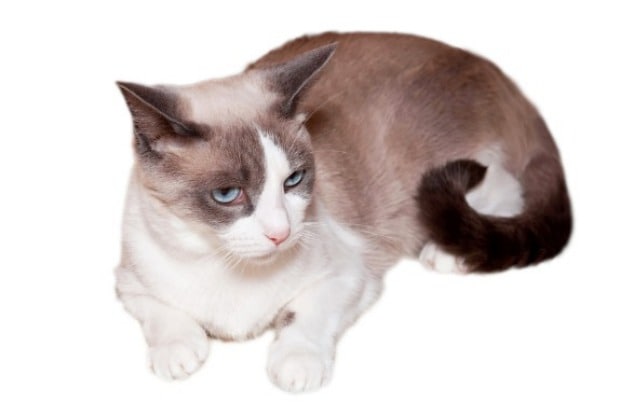About the Snowshoe Cat Breed
Snowshoe cats, known for their blue eyes and white “snowshoe” feet, act more like people than cats. These intelligent felines can learn tricks, love being near their families, and share the talkitive nature of the Siamese, with the warm nature of the American Shorthair.
Snowshoe Physical Characteristics
The Snowshoe is long, stout, medium-sized cat with startling blue eyes. It has an athletic build, with a tendency to be stocky in appearance.
Color(s)
Blue, lilax, chocolate or seal point. “Point” is in reference to a pale body color with relatively darker extremities; i.e., the face, ears, feet and tail. The breed’s white feet are its most distinguishing feature (and the reason for breeds name), with the white frequently extending to the ankle, giving the feet a sock, or boot appearance.
Coat
Smooth and short.
Snowshoe Personality and Temperament
Activity Level
Moderate
Positives
Snowshoes thrives on social contact. The Snowshoe gets along well with most, but has a tendency to bond with one particular person in the home, and is shy with strangers. Sweet-tempered and clever, this is an intelligent breed that can be taught a variety of tricks.
They find water fascinating and do not mind getting wet; they may even go for a swim in the bathtub sometimes. The Snowshoe is not considered a loud cat, but it is not a quiet cat either. This breed is particularly vocal and loves to “talk.”
Things to Consider
If you want a solitary cat or one that needs little companionship, this is not the pet for you. Snowshoes ooze friendliness and affection, and especially love to be touched.
This is not a cat that does well with being left along for long stretches of time.
Snowshoe Care
Ideal Living Conditions
Snowshoe cats do not require any special care beyond doing best when they are around their people, or companion cats and dogs.
Special Requirements
This is a fantastic cat for a family, but not much of a loaner. They are happiest when not left alone for long stretches.
Snowshoe Health
Snowshoe cats do not have any known congenital or geneitc conditions although they may have crossed eyes, like some Siamese, or a kinked tail.
Snowshoe History and Background
In the late 1960’s Dorothy Hinds-Daugherty, a Siamese cat breeder in Philadelphia, was startled to find three kittens in a litter with the common Siamese pattern, but with unusual white feet and “socks” (the Snowshoe name came from this characteristic, because their feet resembled snow-shoes).
Fascinated by them, she devoted much of her time developing a breed based on these characteristics. It was slow work and Dorothy was not finding much success, so she sought the help of another breeder, Vikki Olander from Norfolk, Virginia. Vikki followed in her footsteps, crossing Siamese cats with American Shorthairs, in an attempt to produce the desired look.
She created some buzz for the newly founded breed and wrote its first standard – an abstract aesthetic ideal for the animal type.
In 1974, the Cat Fanciers’ Foundation (CFF) and the American Cat Association accepted the Snowshoe as an experimental breed. It was still slow work, however. Not many breeders showed interest in this nascent breed, and by 1977 there were only a handful of registered Snowshoes and Vikki was the sole U.S. breeder of Snowshoe cats. Over the next few years interest grew incrementally. Vikki was joined by more breeders, and their hard work yielded greater results. The CFF upgraded the breed’s status from experimental to provisional, and in 1982 it was approved for championship status by the CFF. The American Cat Fanciers Association followed with approval for championship status in 1990, and in the fall of that year the fist Snowshoe was awarded grand champion: Birmack Lowansa of Nishna.
The Snowshoe is a rare cat, because of the strict standards for breeding and markings. It is rarely outcrossed with American Shorthairs anymore. Breeders prefer the Oriental Shorthair, and the older type of Siamese (i.e., the heavier body, rather than the longer sleeker Siamese that is bred now) for better and more consistent color and markings. Despite its sluggish start, this new breed is gradually making inroads into the hearts (and homes) of pet lovers worldwide.
By: Chewy Editorial
Share:









